Have you ever used DMC Memory Thread? Have you wondered what it is and how to use it? Or, especially, how to hide the ends of a thread like that on a surface embroidery project?
The other day when we looked at this Fiesta Fob embroidery project, questions poured in, wondering what the thread was, how to use Memory Thread, and especially wondering how I took care of the ends of the thread.
Today, we’ll talk about Memory Thread, what it is (and what it’s not), how to use it, and especially how to take care of those ends.
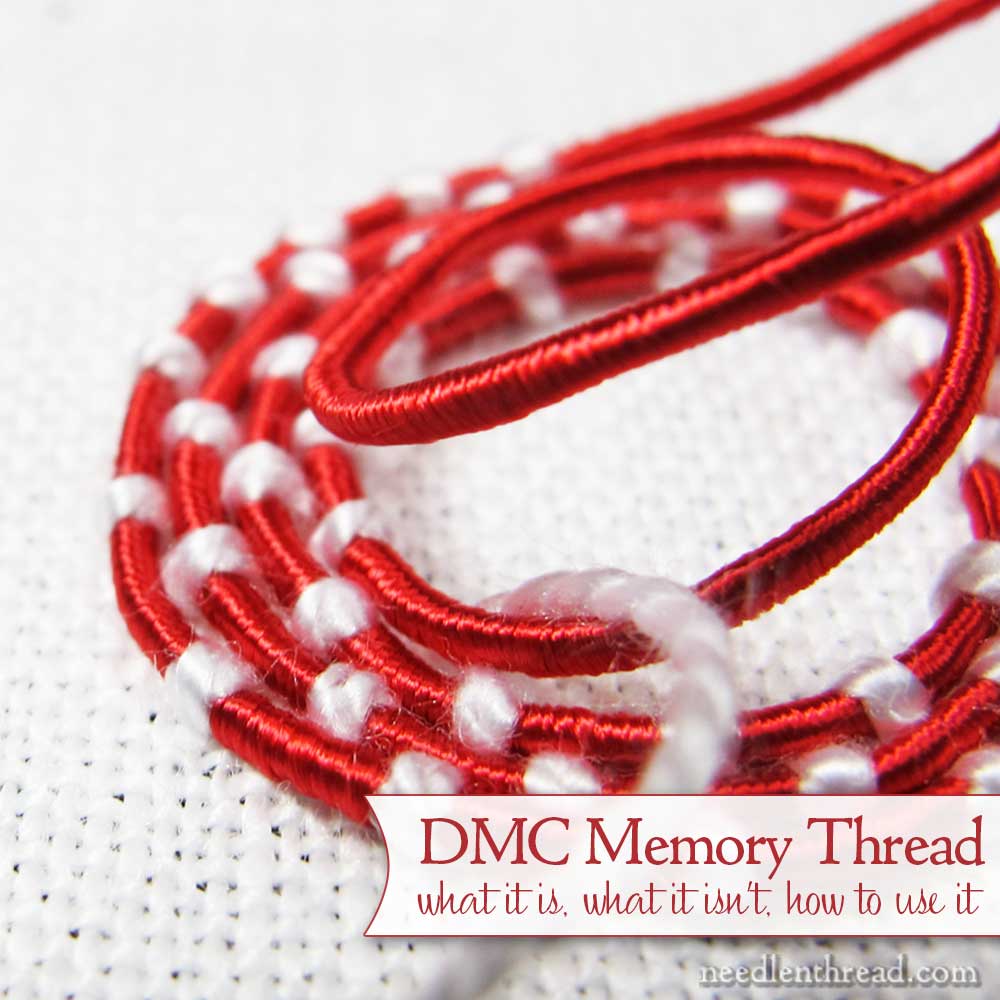
What is Memory Thread?
DMC Memory Thread is a wrapped wire thread that can be manipulated, bent, coiled and curled, and because of the wire center, it retains its shape.
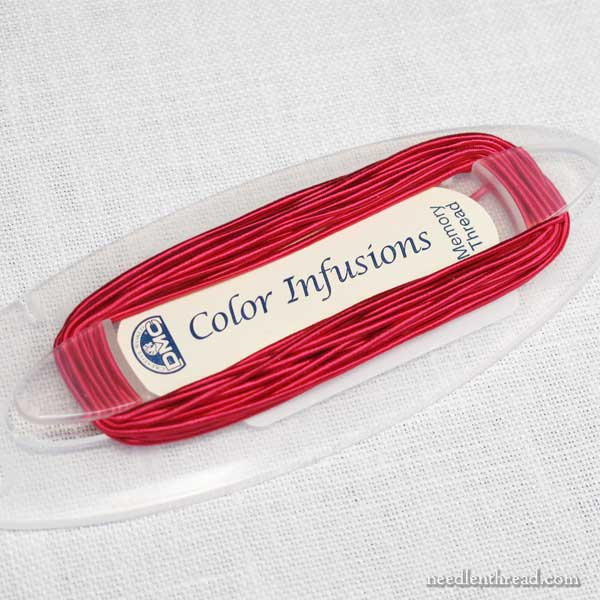
It’s labeled as Color Infusions Memory Thread. You’ll find it through some local needlework shops, but it’s pretty commonly available by the DMC threads at hobby and craft stores like Hobby Lobby, Michael’s, and JoAnn’s here in the States.
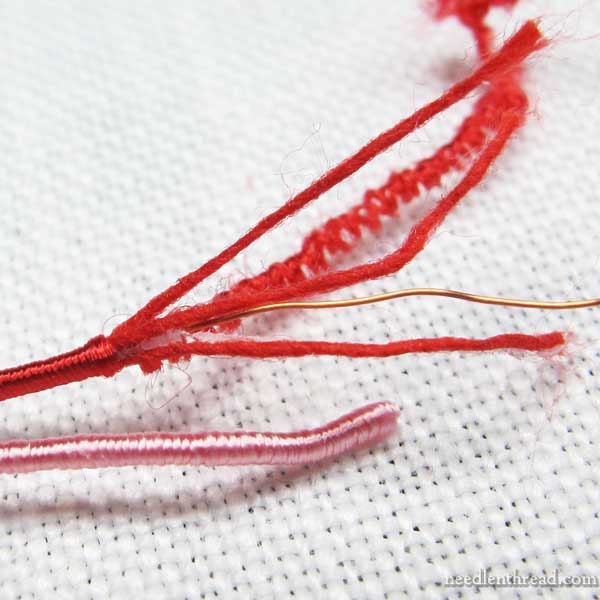
Above, you can see the structure of Memory Thread. At the core is a copper wire, surrounded by three fibers that sort of stick together. Between two of the fibers (hard to see in the photo), I notice that there’s a kind of bonding residue. It’s white and it feels like stabilizer of some sort.
The curly fiber in the background is the viscose (rayon) thread that wraps all around the bundle. The pink thread in the foreground is a piece of Memory Thread intact.
What Memory Thread is Not
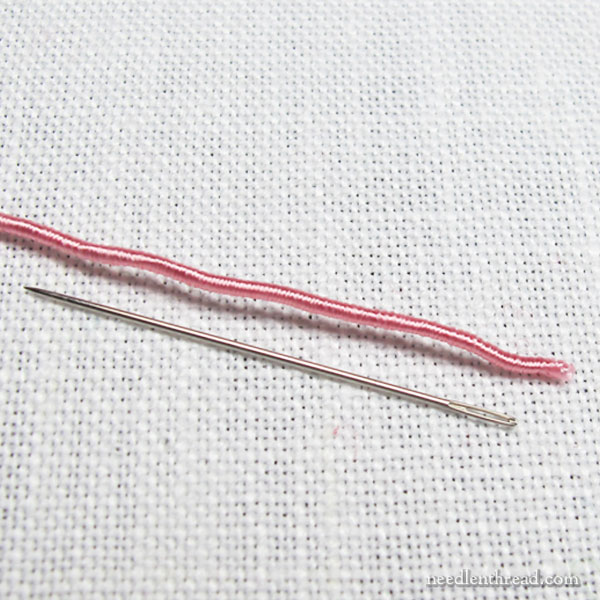
Above, you can see a piece of Memory Thread lying next to a #10 crewel needle. You can tell that it’s definitely a thick thread.
Because of its thickness and especially its stiffness, Memory Thread is a surface embellishment, not a stitchable thread. It doesn’t work for normal embroidery stitches, but it does work well couched.
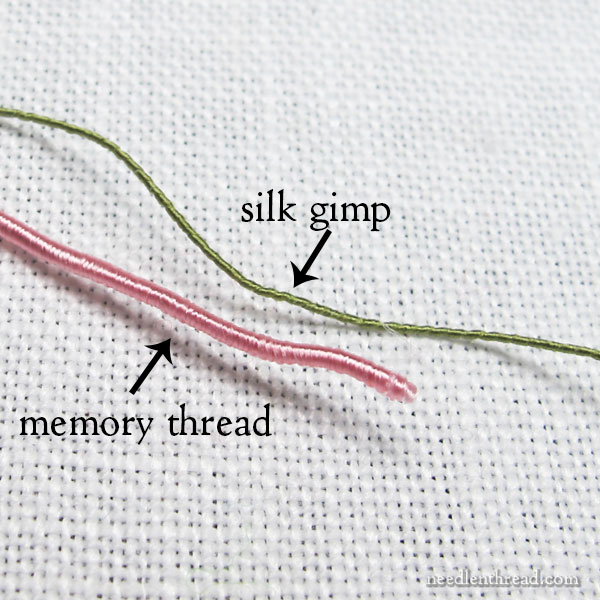
I’ve been asked if Memory Thread is a good substitute for silk gimp. No, it isn’t. Aside from slight visual similarities (they’re both made of threads wrapped around a core), Memory Thread isn’t at all like silk gimp.
Memory thread is stiff; silk gimp is not. Memory thread is thick and heavy; silk gimp is a fine thread. Memory thread is made from viscose wrapped around a copper wire. Gimp is made from silk, wrapped around a silk core, which makes it supple and soft – almost fluid, in a way. Memory Thread is far from “fluid” – it’s like working with heavier, shiny florist wire.
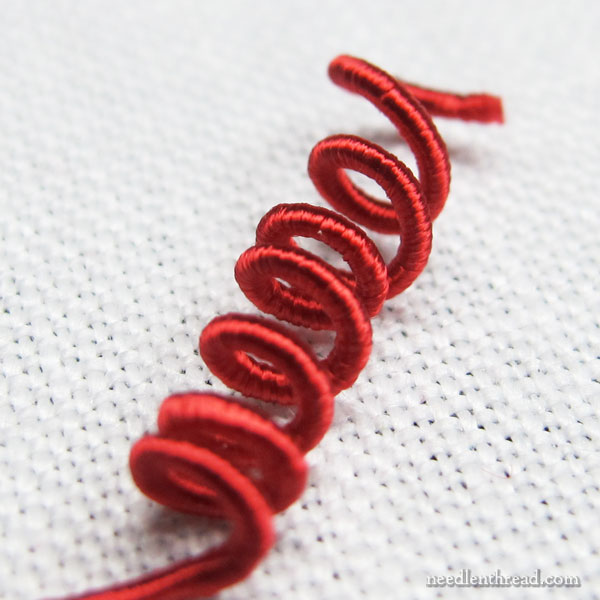
Take your laying tool or stiletto and wrap Memory Thread around it, and you can coil it up, and it will retain its coils. You can manipulate those coils, you can couch the coiled thread onto your fabric. It can be a fun embellishment!
Because you can coil it like this and it retains its shape, I’ve been asked if it would make a good substitute for silk wrapped purl, which is what I used for the leaves on this autumn tree made from silk gimp and silk wrapped purl.
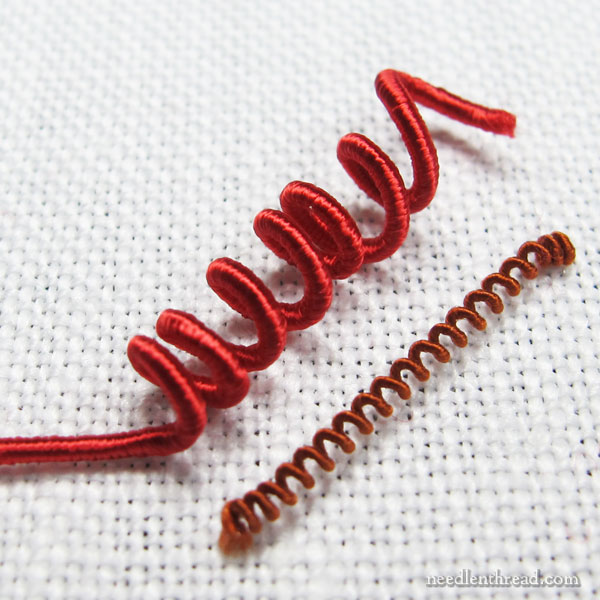
Memory Thread on the left; silk wrapped purl on the right.
Silk wrapped purl, which is a coiled thread made from a very fine wire wrapped with flat silk, is much finer than Memory Thread. When stretched so that the coils are more visible, its coils are even. Memory Thread looks gargantuan in comparison, and would not make a good substitute.
How to Use Memory Thread
Memory Thread is a great thread for surface embellishment on fun embroidery projects.
Because it’s not a stitchable thread, it should be couched on the surface of the fabric. You can use couching thread that matches the color of the Memory Thread so that the stitches are invisible, or you can use contrasting colors, so that the couching stitches are part of the visual effect.
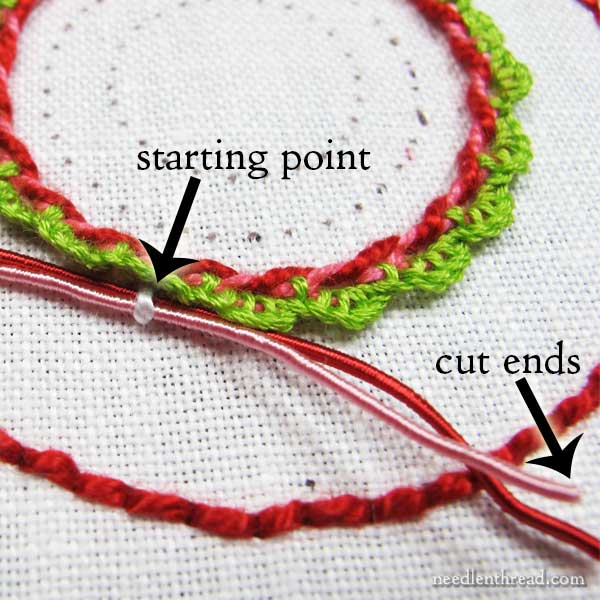
In the made-from-stash Christmas ornament that I started yesterday, I’m using Memory Thread because I have some in my stash.
I began couching the Memory Thread at a spot where the beginnings and ends of the threads would be less noticeable. I’m couching two pieces together at one time, using white #5 perle cotton as my couching thread.
I left about a 1.5″ tail of Memory Thread past the first couching stitch. You can see the cut ends in the photo above.
I did not cut a length of thread off the bobbins – I left the thread wound on the bobbins and just fed it off as I needed more.
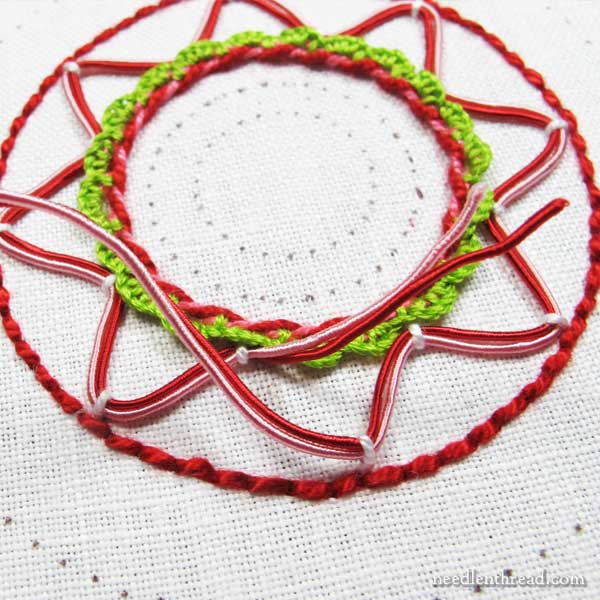
I worked all the way around my circle, couching the Memory Thread in waves. Arriving back at that first couching stitch, I cut the threads from the bobbins. All four cut ends are loose on the front of the fabric in the photo above.
I did not ended my couching thread at this point – I just pulled it to the side until I took care of the Memory Thread ends.
When working with a thread like this, do not use your good scissors to cut the thread!! You’ll ruin them! Use sharp, but inexpensive, scissors when cutting wires.
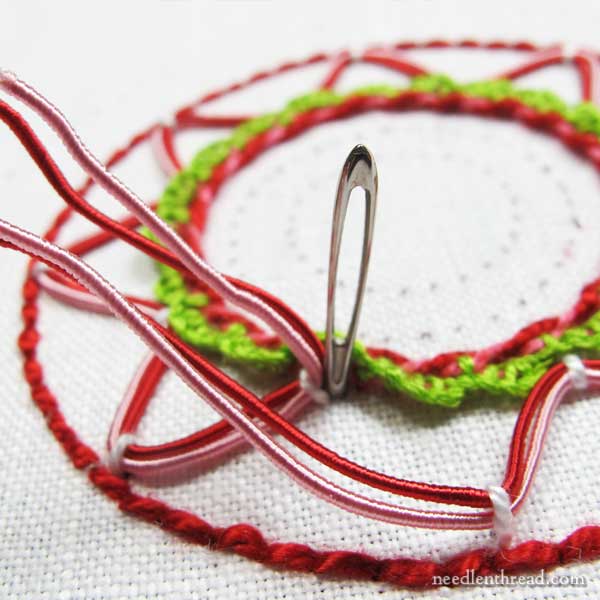
To hide the ends, we’ll plunge them! Plunge them right at that first couching stitch.
Use a very big (as in at least an 18, but a 13 is better) chenille needle. Place the needle in the fabric where you want the threads to go to the back, leaving just the huge eye on top.
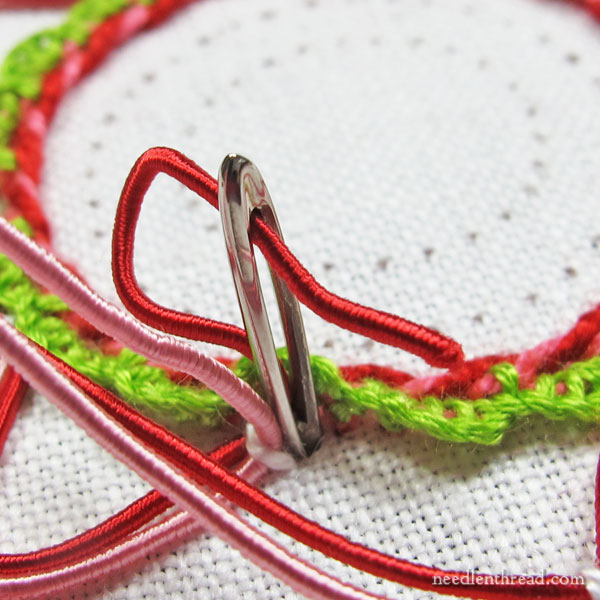
Working with one thread end at a time, manipulate the cut end into the eye of the needle.
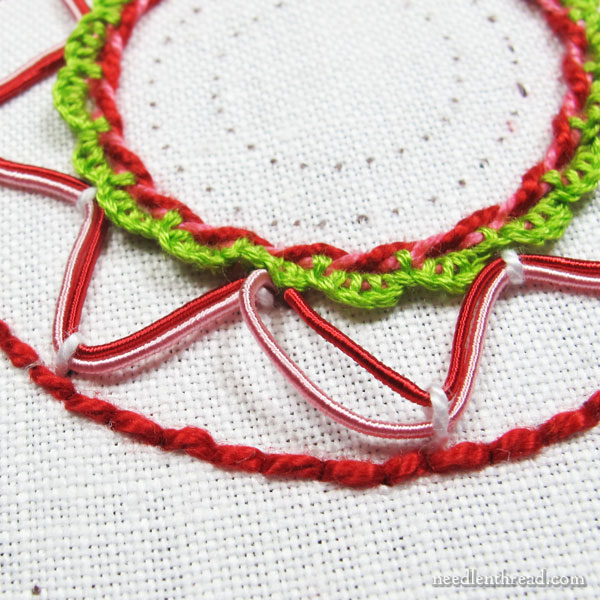
Pull the thread ends through to the back, one at a time. Pull gently – you don’t want to pull your couched Memory Thread out of whack on the front.
Once the threads are pulled to the back, arrange the layout of the Memory Thread on the front, to make sure everything is where you want it.
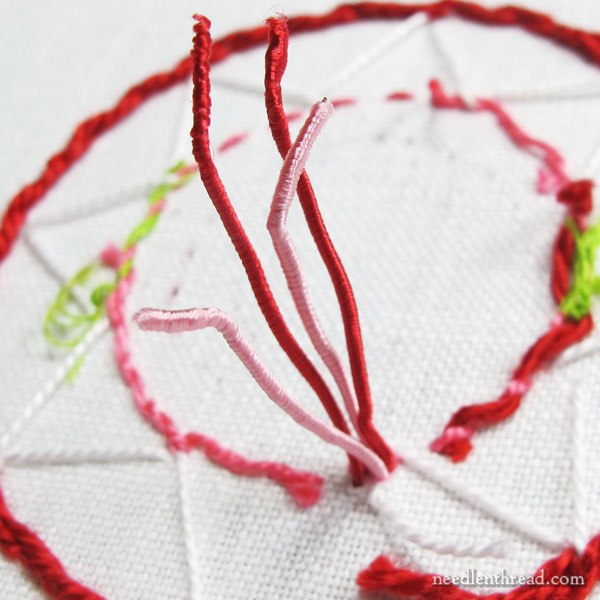
Turn the work over, and you’ll find the cut ends! Cute, aren’t they?
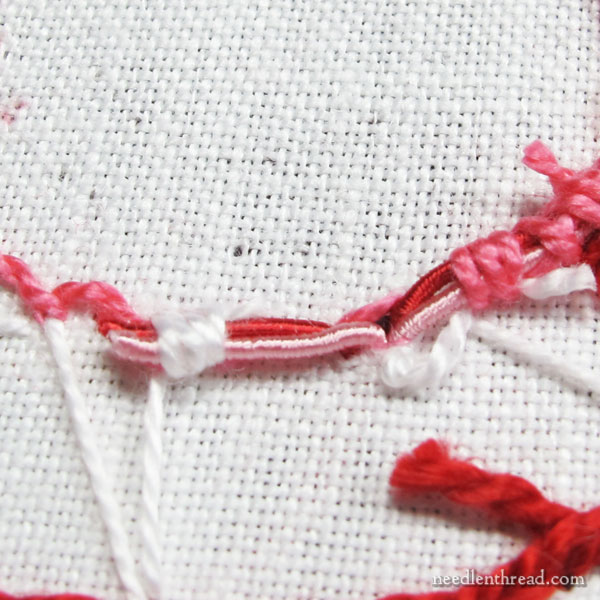
Fold the Memory Thread back in the direction it came from on the front. In this case, since I have four threads, I’m going to secure two together at a time.
Use your couching thread (which you didn’t end, remember?) to whip over the Memory Thread, attaching it to the backs of previously worked stitches. You just need a few stitches to hold the Memory Thread down. Once it’s securely down, cut the excess Memory Thread away.
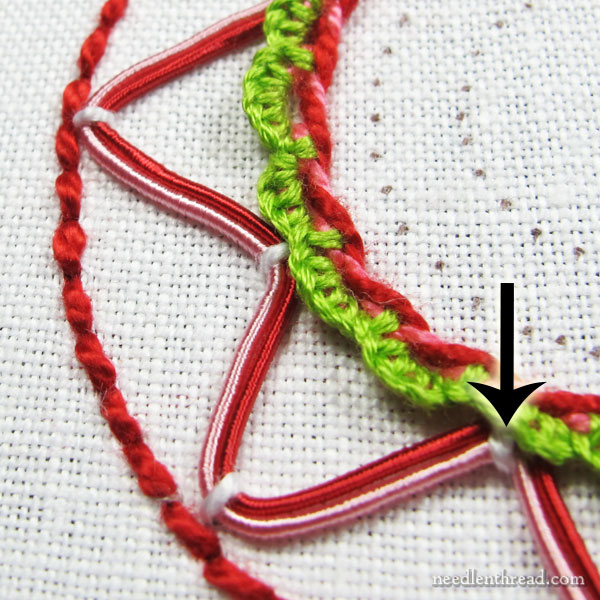
On the front, you can’t see where the threads were plunged. The arrow points to the spot. It helps that it was in a discrete area, under the ruffled stitches of the buttonholed cable chain stitch from yesterday.
The key to invisible beginnings and ends of Memory Thread on a project is determining a discrete place on your design to begin and end the thread. Then you can plunge the threads to the back and you don’t have to worry about covering up the ends on the front.
Some stitchers keep the ends on the front, and just stitch over them securely. That can work, too. It’ll work best, though, if it’s done somewhere discrete as well, so the cut ends don’t show.
And that is Memory Thread!
It’s a really neat embellishment on casual, fun embroidery projects. If you haven’t tried it, now you know how to use it!
Over to You…
Have you used Memory Thread? How do you begin and end yours? Any tips to add? Any questions, comments, ideas, musings? You’re welcome to join in the conversation below!
Needle ‘n Thread, Daily!
Did you know there are seven terrific reasons to sign up for the Needle ‘n Thread daily newsletter? Check them out and sign up today!







Hi Mary! I like the way you said memory thread can be used on fun
Projects, because it IS a fun thread. I made plastic canvas boxes to
Hold Grandkids crayons, etc. and put their names on them with
Memory thread. I have also used it on counted thread pieces,
Needlepoint, etc. It is easy to use in my opinion and has become
A part of my on hand stash. Sue in Bermuda.
Hi Mary,
I saw this thread for the first time while wandering through JoAnn’s yesterday (cheap entertainment and better than a movie). I noted the wire and heft of the thread and thought “I wonder…..?” And here you are presenting it today. Small world and thanks!
That’s funny, Helen! Serendipitous! It’s fun stuff!
Dear Mary
I not used the DMC memory thread before but I just ordered some from Sewandso here in the UK, I was surprised that they stocked the thread but also very pleased not I can play around with it. I love these articles on the Christmas ornaments and thanks for the patterns from yesterday’s blog and for show us how to use the DMC memory thread. The Christmas Fob it looking really pretty, I might join in on this. Thanks for this and I hope you have a great weekend.
Regards Anita Simmance
Dear Mary
Sorry for the not very good confusing message above, my sister is here and I’m trying to do two things at once.
Regards Anita Simmance
🙂 I hope you’re having a blast with your sister!! I’m getting ready to go shopping with mine… 🙂
Oh, thank you for sharing the end of the story – how to end the ends of the Memory Thread. 🙂 I have used it before on a DMC Pink project actually. It’s unusual “thread” but fun to play with. I just dabbed a tiny touch of glue on the cut ends to keep the wrapped thread in place. It does tend to uncoil and fray off the end. Then I couched the ends securely and to make them look neat. It worked but plunging seems the best way.
And would you plunge an end that can’t be hidden, say the end of a floral tendril hanging out alone on the fabric? I’d worry the thread would bulge and show through a bit.
Yes, you can plunge them anywhere – it does create more bulk on the back, though. Just secure it pretty tightly right under the couched memory thread….
You can also use a bit of Fray Block or Fray Check on the end. It is a liquid plastic and dries clear, although Fray Check might darken the color of the thread a bit if you put too much on. They should both be available in the notions department of your local fabric store.
If you go to the DMC-USA.com website, there are more tips on how to use Memory Thread. Also, on the Color Card for Memory Thread, it lists the corresponding DMC cotton floss number for couching.
Hi Mary,
I’m one of those who asked how did you start and end your thread. I just want to thank you for taking the time to explain and show us.
Thanks again
I have been doing a little stump work, and use memory thread. Thought that was what it was for. Thank you for the info. jean
Thanks, Mary! I can’t wait to try this stuff with beadwork! If there is nowhere to “plunge” the end, I might glue a bead to the end. . . . I am having questions about “discrete” (separate, individual) versus “discreet” (cautious, low-key, mannerly). In all your work you certainly go gently, go easy, and go gracefully, but . . . if I’m puzzled, I’m also concerned for your ESL followers.
Our EGA group did an experimental piece that was in one of the magazines, an owl, but I was not too happy with it. The thread is not difficult to work with and if you have any experience with gold work or using oversized threads the techniques are the same. I suppose that if you wanted to learn various couching techniques it would be an inexpensive way to experiment, however I am not a fan.
Hello – would this work on stumpwork? I’m only just beginning to try stumpwork, so thought this might be useful.
Great site. Sorry I should say ONLY SITE for me, as I’m just beginning embroidery as well!
Jean
Hi, Jean – sure, it could be used in Stumpwork projects. So glad you enjoy Needle ‘n Thread!
This was very helpful. Thank you!! Blessings
I’m slowly reading through your blog, and have really enjoyed discovering all the threads and books you review. I started reading around 3 months ago (May 2025), and have managed to find most of the books and threads. So today i thought I’d look up this Memory Thread because it looks really interesting. I think DMC must’ve cancelled the line because it’s no longer on their website (I’m in the UK), so I looked around to see if I could find it anywhere else. I did. £360 for 3 yards!!! And that was the cheapest I could find it, and I could only find it in 2 shades of red and a sickly pink.
I don’t think I’ll be using Memory Thread in my embroidery!!
Yes, they discontinued it.